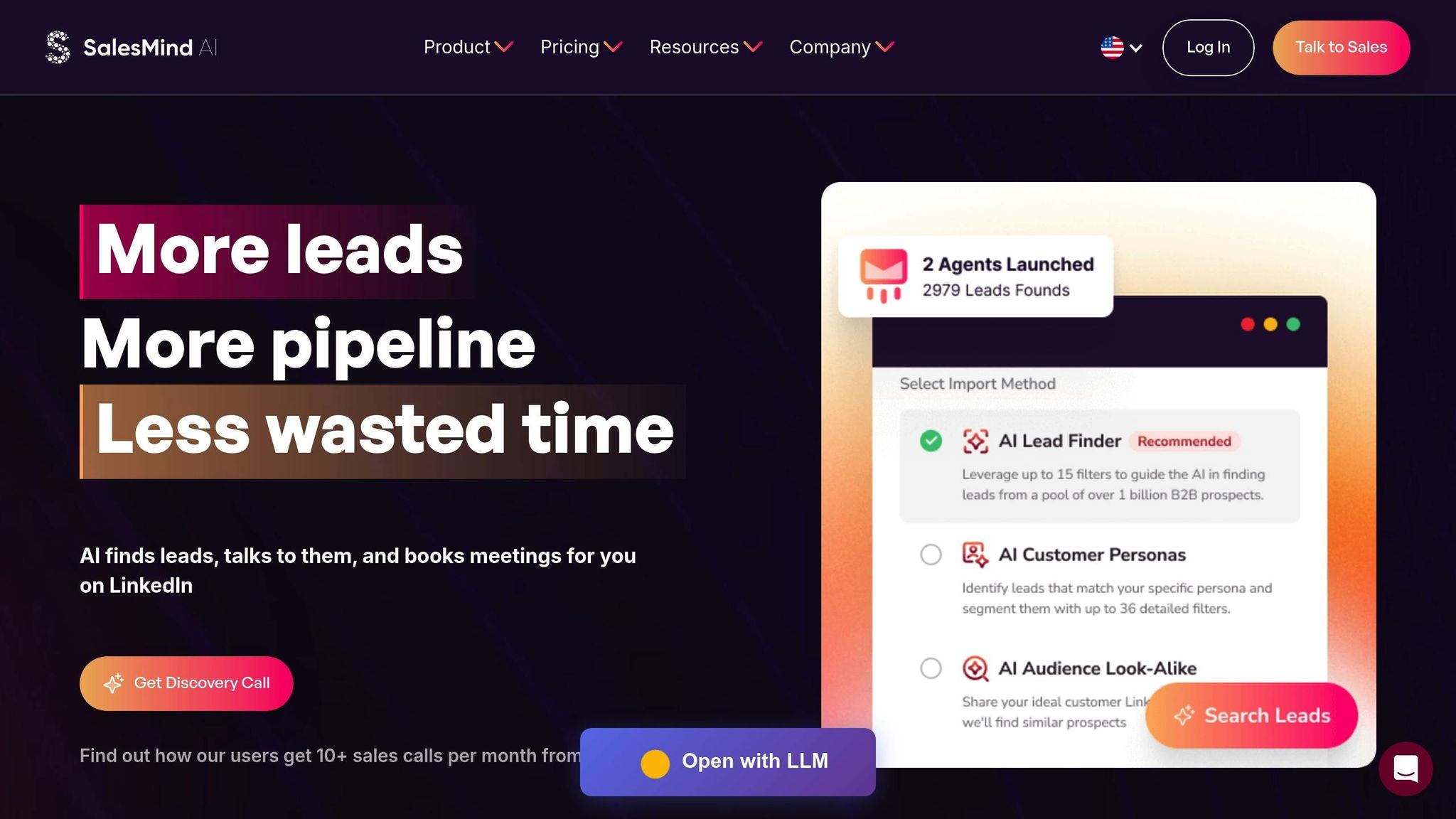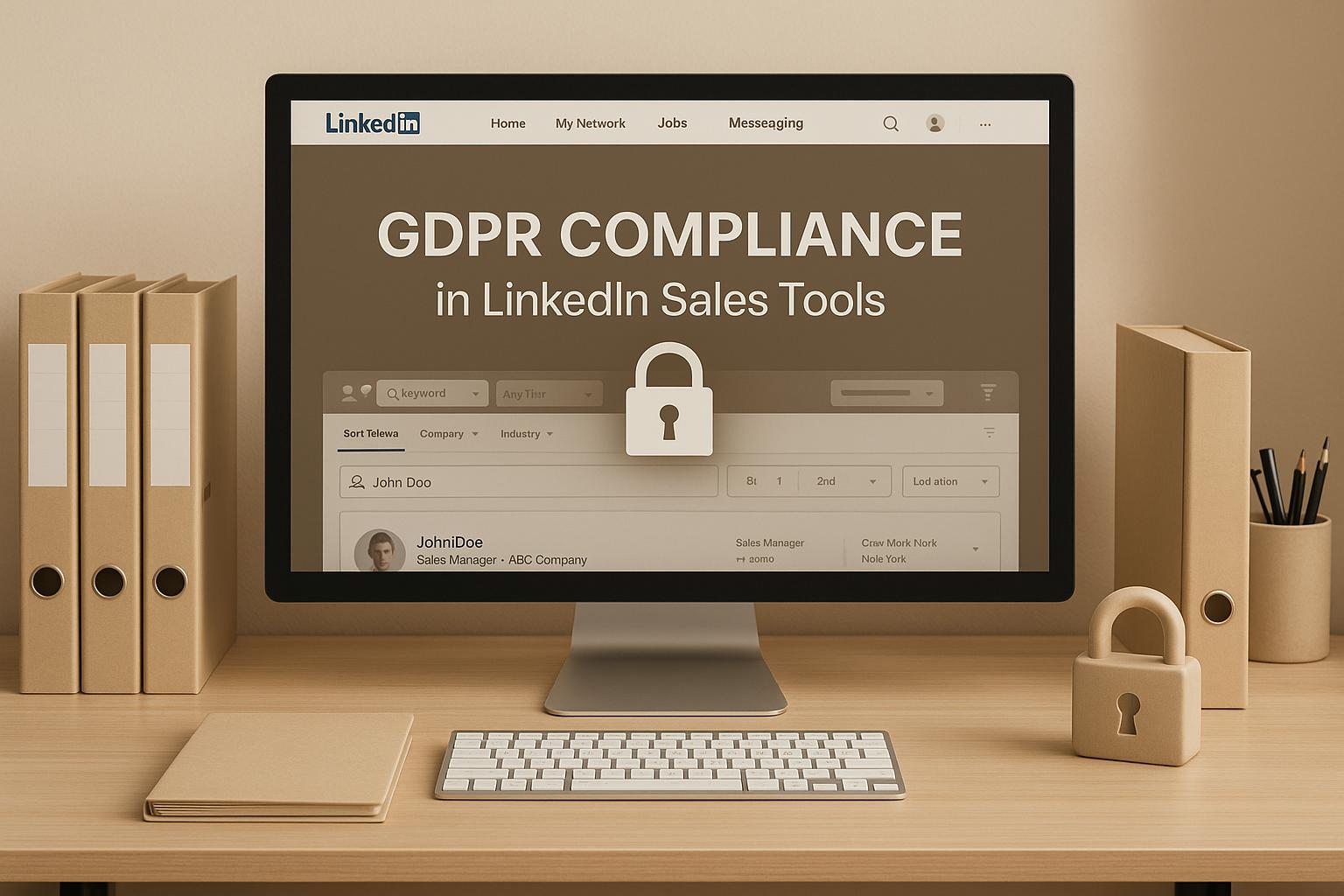
.avif)
Julien Gadea
Julien Gadea specializes in AI prospecting solutions for business growth. Empowering businesses to connect with their audience with SalesMind AI tools that automate your sales funnel, starting from lead generation.
AI tool performance metrics measure how effectively AI systems work in business settings. These metrics focus on technical and operational aspects, such as processing speed, prediction accuracy, and user engagement, while linking them to business outcomes like lead conversion rates or reduced sales cycle lengths. For example, tools like SalesMind AI have shown a 20% boost in qualified leads and a 15% shorter sales cycle.
Key Metrics to Track:
- Lead Scoring Accuracy: Measures how well AI identifies high-converting leads.
- Conversion Rates: Tracks success at different sales stages, from outreach to closing.
- Sales Cycle Length: Evaluates time saved by automating tasks like follow-ups.
- Customer Acquisition Cost (CAC): Assesses the cost-effectiveness of acquiring new customers.
- Customer Lifetime Value (CLV): Tracks long-term revenue generated per customer.
- Pipeline Health: Monitors deal quality and distribution across sales stages.
- Forecast Accuracy: Measures how closely revenue predictions match actual results.
Why It Matters:
Tracking these metrics helps businesses:
- Optimize Sales Processes: Identify strengths and areas for improvement.
- Justify Investments: Link AI performance to ROI with measurable outcomes.
- Improve Efficiency: Automate repetitive tasks and reduce administrative burdens.
By regularly monitoring these metrics, businesses can refine their strategies and achieve consistent growth.
Sales Data Analysis AI Agent - How to Guide
Core Metrics for Evaluating AI Sales Tools
When it comes to assessing the effectiveness of AI sales tools, three key metrics can provide a clear picture of their impact. These metrics directly influence your bottom line, offering insights into performance and helping identify areas where improvements can drive better results. Let’s dive into these metrics and what they reveal.
Lead Scoring and Qualification Accuracy
One of the most important metrics is lead scoring accuracy, which measures how well your AI tool identifies prospects most likely to convert into customers. By comparing the AI's predictions to actual sales outcomes, you can evaluate whether your team is focusing on the right opportunities.
To monitor this, track the percentage of AI-identified leads that convert and analyze patterns of false positives and negatives. For example, SalesMind AI’s advanced lead scoring system has shown a 25% increase in qualified lead conversions, while also reducing the time wasted on poor prospects.
The time savings here are significant. Instead of spending hours manually researching and qualifying leads, your sales team can rely on the AI to handle this process. Many users report receiving 4–5 daily responses from outreach efforts, creating a steady flow of opportunities to schedule meetings and close deals.
Conversion Rates at Different Sales Stages
Conversion rates across various stages of the sales funnel provide another crucial metric. Breaking down these rates - from initial contact to qualification, proposal, and closing - helps pinpoint where your AI tool is most effective and where improvements are needed.
For instance, your tool might excel at generating initial interest but need fine-tuning in lead qualification. Or perhaps automated follow-ups are especially effective at moving prospects from proposal to closing. Comparing conversion rates before and after AI implementation can highlight these trends. According to Salesforce's 2023 study, companies using AI tools have seen a 27% boost in sales productivity and a 19% increase in conversion rates [1][2].
A practical example is LinkedIn outreach campaigns. When SalesMind AI automates personalized messaging and follow-ups, businesses can measure response rates, meeting bookings, and eventual conversions. This stage-by-stage tracking helps refine messaging strategies for each step of the buyer’s journey.
Reduction in Administrative Tasks and Sales Cycle Length
AI tools excel at automating tedious tasks, freeing up your team to focus on high-value activities. Measuring time saved and reductions in sales cycle length can show how effective your AI implementation is. This includes tracking the number of hours saved weekly and the percentage of sales activities automated.
Automating tasks like data entry, follow-ups, and lead research can significantly reduce workload. McKinsey & Company research shows that AI-powered tools can cut administrative tasks by up to 50% [1][2]. For instance, a mid-sized B2B software company that implemented an AI system in January 2024 saw a 35% increase in qualified leads and a 20% reduction in time spent on manual lead qualification within three months. These improvements, combined with reduced administrative burdens, had a noticeable impact on their sales performance.
SalesMind AI’s features, such as a unified inbox and automated follow-ups, further streamline workflows. Clients report cutting administrative workloads by up to 50% and shortening sales cycles from an average of 45 days to 35 days - a 22% reduction. This 10-day improvement translates into faster revenue generation and better cash flow.
The Bigger Picture: Combined Impact
These metrics collectively highlight the game-changing potential of AI sales tools:
| Metric | Typical Improvement with AI | Source |
|---|---|---|
| Lead Scoring Accuracy | 27% increase in sales productivity | Salesforce, 2023 |
| Conversion Rates | 19% increase | Salesforce, 2023 |
| Sales Cycle Length | 22% reduction | HubSpot, 2024 |
| Administrative Task Reduction | 50% reduction | McKinsey & Company, 2024 |
When evaluated together, these metrics often have a compounding effect. For example, better lead scoring accuracy can lead to improved conversion rates, while reduced administrative tasks often result in shorter sales cycles. This interconnected impact can significantly enhance your overall sales performance.
Advanced KPIs for AI-Driven Sales Automation
When you move beyond basic metrics, advanced KPIs offer a deeper understanding of how AI tools influence efficiency and profitability. These metrics paint a clearer picture of whether your AI investment is driving sustainable growth and complement the core KPIs to give you a more complete view of your sales performance.
Pipeline Health and Forecast Accuracy
Pipeline health isn’t just about the total value of opportunities in your sales funnel - it’s about their quality and predictability. This includes several key factors.
Maintaining a pipeline coverage ratio of 3:1 to 5:1 relative to your sales quota is crucial. For instance, if your quarterly sales target is $500,000, your pipeline should ideally range from $1.5 million to $2.5 million. AI tools can help sustain this balance by consistently feeding qualified leads into your funnel.
Another critical aspect is the distribution of opportunities across sales stages. A healthy pipeline spreads deals across all stages rather than clustering them in one phase. A bottleneck in a particular stage might indicate a problem that needs attention, and AI automation can help identify these patterns.
Forecast accuracy is another essential metric. This measures how closely your predicted revenue aligns with actual results. For example, if you forecast $500,000 in revenue for Q4 but close $475,000, your accuracy is 95%.
In Q2 2023, Salesforce revealed that their AI-powered tool, Einstein Forecasting, helped a Fortune 500 company improve forecast accuracy by 18% and reduce errors by 22% in six months. By using real-time pipeline tracking to address bottlenecks, the company increased its win rates by 12%. [4]
AI-powered sales systems often achieve forecast accuracy of 90% or higher. Automated lead qualification and follow-ups reduce variability in deal progression. According to McKinsey, companies using AI for sales forecasting see 15–20% better accuracy compared to manual systems [4].
Next, let’s look at how AI impacts customer acquisition costs and lifetime value.
Customer Acquisition Cost (CAC) and Lifetime Value (CLV)
Balancing the cost of acquiring customers with their long-term value is essential for sustainable growth. Customer Acquisition Cost (CAC) is calculated by dividing total sales and marketing expenses by the number of new customers acquired. For example, if you spend $100,000 to acquire 50 customers, your CAC is $2,000. AI tools can reduce CAC by automating time-consuming tasks like prospecting and lead qualification, allowing your team to focus on higher-value activities.
Customer Lifetime Value (CLV), on the other hand, represents the total revenue a customer generates during their relationship with your business. To calculate this, multiply the average annual revenue per customer by their average lifespan. For instance, a customer generating $10,000 annually over five years would have a CLV of $50,000.
An ideal CAC-to-CLV ratio is 1:3 or higher. For example, a $2,000 CAC paired with a $50,000 CLV gives you a strong 1:25 ratio.
In January 2024, HubSpot reported that its AI-driven sales platform helped a mid-sized B2B software company cut customer acquisition costs by 27% and boost customer lifetime value by 35% in 12 months. Advanced lead scoring and real-time pipeline tracking were key to improving their sales process and conversion rates. [4]
SalesMind AI's automated LinkedIn outreach also helps improve this ratio by targeting prospects who are more likely to become high-value, long-term customers. Its advanced lead scoring system identifies prospects with traits similar to your most successful customers.
| KPI | Improvement with AI | Source |
|---|---|---|
| Forecast Accuracy | 15–20% increase | McKinsey, 2023 [4] |
| Customer Acquisition Cost | 25–30% reduction | Salesforce, 2024 [4] |
| Customer Lifetime Value | 20–35% increase | HubSpot, 2024 [4] |
Real-Time Tracking: Velocity and Deal Movement
Sales velocity measures how quickly deals progress through your pipeline. It’s calculated using this formula: (Number of Opportunities × Average Deal Value × Win Rate) ÷ Sales Cycle Length. For example, with 100 opportunities at an average deal value of $50,000, a 30% win rate, and a 60-day sales cycle, your daily velocity would be around $25,000. AI tools enhance each variable by generating more qualified leads, improving targeting, ensuring consistent follow-ups, and shortening the sales cycle.
Real-time tracking systems provide immediate visibility into deal status, enabling quick decisions and timely action on stalled deals. By integrating your CRM with AI tools, you can automatically log interactions - like LinkedIn messages, responses, and stage changes - while dashboards display key metrics such as deals by stage, days in each stage, and upcoming action items. Alerts can flag stalled deals, such as a $100,000 proposal that hasn’t seen activity in over 10 days, prompting immediate follow-up.
SalesMind AI’s unified inbox offers real-time visibility into message performance, lead scoring updates, and suggested next steps. You can monitor open rates, response rates, and deal progression as they happen, allowing you to address potential issues before they affect revenue.
Together, these advanced KPIs work in harmony to elevate sales performance. Improved forecast accuracy leads to smarter resource allocation, while better CAC-to-CLV ratios and real-time velocity tracking enable proactive management. The result? Continuous improvement and sustainable growth.
sbb-itb-817c6a5
Steps to Set Up and Track AI Tool Metrics
Tracking the performance of an AI tool requires a systematic approach to turn raw data into actionable insights. The process involves three key steps: selecting the right framework, integrating data sources, and establishing regular monitoring routines.
Choosing the Right Analytics Framework
The analytics framework you choose is the backbone of performance tracking. It should align with your business goals and support the specific metrics you need. For instance, metrics like prediction accuracy rates between 85–99% are critical for high-quality decision-making, while false positive rates below 5% help optimize resource allocation [5]. When evaluating platforms, focus on compatibility with your current tools. For example, if your team relies on Salesforce for CRM and LinkedIn for outreach, the framework must integrate smoothly with both.
Scalability is another factor to consider. The system should manage growing data volumes as your business expands without requiring a complete overhaul. Real-time monitoring capabilities are also essential, as even small delays - measured in milliseconds - can impact user experience and conversion rates [5]. Commonly used platforms include Google Analytics for web tracking, Power BI for broader business insights, or custom dashboards tailored to your needs.
Once you’ve selected a framework, the next step is connecting your data sources to get a complete performance picture.
Integrating Data Sources for Complete Tracking
Combining data from multiple sources provides a comprehensive view of your AI tool's performance. Start by identifying all relevant data inputs, such as CRM systems, LinkedIn engagement metrics, email platforms, and any analytics tools you already use. APIs or middleware can automate the synchronization of this data, reducing errors and keeping your metrics up to date.
Standardizing data formats is crucial for accurate analysis. Consistent rules for dates, currencies, and other variables prevent discrepancies in reports. For example, in 2023, a B2B SaaS company integrated its AI sales tool with Salesforce and LinkedIn to streamline lead engagement tracking. By introducing weekly dashboards and monthly executive reviews, the company boosted lead qualification accuracy from 82% to 94% and cut manual data entry time by 40% [5]. Addressing data silos with tools for ETL (Extract, Transform, Load), validation processes, and pre-built integrations ensures that your data remains reliable.
With integration complete, the focus shifts to automating monitoring and reporting for continuous improvement.
Setting Up Regular Monitoring and Reporting
Consistent monitoring is key to identifying performance issues early and making timely adjustments. Critical metrics like system response times and user engagement rates should be reviewed daily. Weekly reports can focus on tactical metrics such as lead qualification accuracy, conversion rates, and pipeline progress. Monthly reviews are better suited for analyzing broader trends, like customer acquisition costs and the length of sales cycles.
Automating data collection and dashboard updates reduces errors and ensures timely insights. Set up alerts for significant changes, such as a drop in lead qualification accuracy or an increase in response times, to enable quick action. Assigning responsibility for reviewing these insights ensures they lead to meaningful decisions.
| Reporting Frequency | Metrics | Purpose | Stakeholders |
|---|---|---|---|
| Daily/Real-time | Response time, system uptime, user engagement | Immediate issue resolution | Technical team, sales managers |
| Weekly | Lead qualification accuracy, conversion rates, pipeline movement | Tactical adjustments | Sales and marketing teams |
| Monthly | Customer acquisition cost, sales cycle length, ROI | Strategic planning | Executives, department heads |
Customizable dashboards that allow users to drill down into specific campaigns, audience segments, or time frames help stakeholders quickly identify trends and areas for optimization.
The ultimate goal isn’t just collecting data - it’s using that data to drive ongoing improvement. Regularly analyzing trends, experimenting with strategies, and measuring the results of changes are essential. For example, if LinkedIn outreach shows low engagement, testing new message templates and monitoring real-time results can lead to better outcomes.
Platforms like SalesMind AI simplify this process by offering customizable dashboards, automated reporting, and real-time tracking. With its integration features, all your sales data is consolidated into a single, actionable view - helping you make smarter decisions and achieve consistent growth.
Case Study: Measuring Success with SalesMind AI

This case study highlights how SalesMind AI transforms sales performance by leveraging advanced metrics, automation, and AI-driven tools. The results? Tangible improvements in key performance indicators that demonstrate the platform's ability to optimize sales processes and outcomes.
Improving Engagement Through Automated Personalization
SalesMind AI takes LinkedIn outreach to the next level by creating personalized messages tailored to individual prospects. By using data like behavior patterns, industry specifics, roles, and engagement history, the platform increases response rates by an impressive 30% [1]. Unlike generic templates, these customized messages resonate more with recipients, driving meaningful interactions.
Businesses can track critical engagement metrics such as:
- Message open and response rates
- Meeting booking rates
- Overall LinkedIn activity (likes, comments, shares)
This data provides insights into the most effective personalization strategies. Additionally, users report that SalesMind AI simplifies the often tedious task of monitoring lead interactions, thanks to its automated tracking features [3]. These engagement improvements lay the groundwork for more effective lead qualification.
Better Lead Qualification with Advanced Scoring
SalesMind AI introduces an advanced lead scoring system that evaluates prospects based on behavior and demographics. By analyzing multiple engagement signals - like LinkedIn activity, message responses, profile visits, and content interactions - the platform assigns scores that help sales teams focus on high-priority leads. The result? A 25% reduction in lead qualification time and a 20% increase in conversion rates [1].
This AI-driven scoring system ensures accuracy and consistency, outperforming traditional manual methods. It also integrates seamlessly with SalesMind AI’s unified inbox, further streamlining workflows and enabling faster decision-making.
Streamlined Sales Workflows with Unified Inbox and Real-Time Tracking
SalesMind AI's unified inbox simplifies the way teams manage LinkedIn conversations by consolidating replies from multiple accounts into one interface. The "One AI Inbox" includes an AI co-pilot that suggests responses, tags leads, and sets reminders, making it easier to manage interactions efficiently [3].
For instance, a B2B software company reported a 40% reduction in time spent on outreach and follow-ups after adopting the unified inbox [1]. Automated follow-ups also contribute to a 15% increase in meeting conversions, ensuring no leads fall through the cracks. This streamlined approach accelerates deal progression by 10% [1].
| Metric | Improvement | Impact |
|---|---|---|
| Response rates | 30% increase | Higher engagement |
| Lead qualification time | 25% reduction | Greater efficiency |
| Administrative time | 40% reduction | Simplified workflows |
| Meeting conversion | 15% increase | Improved follow-up timing |
Users consistently praise the platform for automating time-consuming tasks, freeing up resources for more strategic activities. By systematically managing lead tracking and engagement, SalesMind AI boosts productivity while reducing administrative burdens.
SalesMind AI’s effectiveness is reflected in its high user satisfaction scores, including 4.4 on Trustpilot, 4.7 on G2, and a perfect 5 on the Chrome Store [3]. These ratings underscore its ability to deliver measurable results through robust tracking and optimization tools.
Key Takeaways on AI Tool Performance Metrics
Tracking the right AI performance metrics is crucial for making informed decisions that fuel business growth.
Summary of Core and Advanced Metrics
As discussed earlier, evaluating both technical and business metrics is essential for effective AI performance assessment. Core metrics like accuracy, precision, and recall serve as the foundation. For instance, improving lead scoring accuracy can help sales teams boost conversion rates. However, even the most accurate models lose their value if sales cycles remain lengthy or customer satisfaction takes a hit.
Advanced metrics go a step further by tying AI performance directly to business outcomes. Metrics like pipeline health and forecast accuracy enable more reliable revenue predictions. Meanwhile, measures such as customer acquisition cost (CAC) and customer lifetime value (CLV) provide insights into the financial impact of AI-driven strategies. Real-time indicators like deal velocity also help track how quickly opportunities progress through the sales funnel.
Many organizations succeed by using a balanced scorecard approach, combining technical and business metrics. This method prevents over-reliance on a single data point, offering a more well-rounded view of how effective your AI tools really are.
| Metric Category | Key Measurements | Business Impact |
|---|---|---|
| Core Technical | Accuracy, Precision, Recall | Improves lead quality and model reliability |
| Advanced Business | CAC, CLV, Pipeline Health | Drives revenue growth and profitability |
| Operational | Latency, Throughput | Enhances user experience and scalability |
These metrics not only evaluate AI tool performance but also help set the stage for meaningful business growth.
How Optimized AI Tools Drive Business Growth
Consistently tracking and analyzing metrics is essential to staying competitive. For example, identifying which personalization strategies improve response rates or which lead scoring factors predict conversions allows organizations to fine-tune their AI systems for better results.
Companies that regularly monitor AI performance metrics are better equipped to respond to market shifts and changing customer behaviors. This adaptability often translates into sustained revenue growth and a stronger competitive edge.
Collaboration across teams amplifies these benefits. When sales, marketing, and IT departments review AI performance data together, they uncover opportunities that might go unnoticed if working in silos. This cross-functional approach drives smarter implementations and encourages broader adoption of AI tools.
Top-performing teams rely on metrics to shape strategic decisions, streamline workflows, and clearly demonstrate ROI to stakeholders. Without a systematic measurement process, organizations risk underutilizing their AI tools and missing out on growth opportunities. By committing to comprehensive metric tracking, businesses can position themselves for long-term success in an increasingly competitive landscape.
When integrated with your overall sales strategy, these insights provide a complete picture of AI performance and its impact on growth.
FAQs
How can businesses use AI tools to shorten their sales cycles and boost lead conversions?
AI tools, like SalesMind AI, are reshaping how businesses approach sales by automating critical tasks such as personalized outreach, lead qualification, and follow-ups. These tools don’t just save time - they also make it easier to connect with prospects in a more targeted way. The result? Shorter sales cycles and better lead conversion rates.
With features like an AI-driven inbox, advanced lead scoring, and smooth LinkedIn integration, businesses can simplify their processes and concentrate on nurturing relationships with high-value leads.
What’s the difference between technical performance metrics and business-focused metrics when assessing AI tools?
Technical performance metrics delve into how effectively an AI tool operates behind the scenes. These metrics include accuracy, precision, recall, and latency - all of which gauge the tool’s computational performance and dependability. They’re critical for evaluating whether the AI is functioning as expected and meeting technical requirements.
In contrast, business-focused metrics measure how the AI contributes to achieving organizational objectives. Metrics like conversion rates, customer acquisition cost (CAC), and return on investment (ROI) reveal whether the AI tool is delivering tangible benefits, such as increasing sales or enhancing customer engagement. By combining these two perspectives, you gain a well-rounded understanding of both the tool's technical performance and its value to your business.
How does tracking sales velocity and deal progress in real time improve the performance of AI sales tools?
Real-time tracking of how deals progress and the speed at which they move through the pipeline is a game-changer for sales teams. AI sales tools use this data to uncover bottlenecks and provide insights that help businesses fine-tune their strategies and make smarter decisions about where to focus their efforts.
This continuous monitoring also allows AI to identify and prioritize high-value opportunities, improve the accuracy of sales forecasts, and automate follow-ups right when they’re needed. By doing so, businesses can ensure no potential customer slips through the cracks. The result? A smoother sales process, greater efficiency, and, most importantly, higher conversion rates.




